#who un-contaminates recycling bins
Explore tagged Tumblr posts
Text
The new 'compost obligatoire' rules came into force on 1 January 2024. Here's what they entail.
As of 1 January 2024, organic waste recycling is mandatory in France under new 'compost obligatoire' rules.
With support from the government’s Green Fund, municipalities must provide residents with ways to sort bio-waste, which includes food scraps, vegetable peels, expired food and garden waste.
Households and businesses are required to dispose of organic matter either in a dedicated small bin for home collection or at a municipal collection point. Previously, only those who generated over five tonnes of organic waste per year were required to separate it.
The waste will then be turned into biogas or compost to replace chemical fertilisers. Alternatively, it can be composted at home.
The obligation is currently on local authorities to provide an easy means for households to compost or separate organic waste.
While facilities are rolled out, there will not be fines imposed for non-compliance. It is yet to be seen whether stricter rules will be imposed in future.
One-third of household waste is bio-waste
Organic waste from food and gardens accounts for almost one-third of household waste. When it is mixed with other rubbish, it typically ends up in landfills or incinerators, where it produces heat-trapping greenhouse gases like methane and CO2.
Food waste is responsible for about 16 per cent of the total emissions from the EU food system, according to the European Commission. Globally, food loss and waste generates around 8 per cent of all human-caused emissions annually, the UN says.
It can also contaminate packaging destined for recycling like paper, plastic and glass.
In 2018, only 34 per cent of the EU’s total bio-waste was collected, leaving 40 million tonnes of potential soil nutrients to be discarded, according to NGO Zero Waste Europe.
In France, an estimated 82 kg of compostable waste per person is thrown away each year.
Is bio-waste separation mandatory in other European countries?
Under the EU’s Waste Framework Directive, bio-waste collection is being encouraged this year, but it stops short of setting mandatory targets.
In many European countries, organic waste separation has already been implemented at the municipal level.
Milan in Italy has been running a residential food waste collection programme since 2014. Households were given dedicated bins and compostable bags to kick off the scheme.
Elsewhere, taxes or bans on incinerating bio-waste have encouraged similar schemes, with separate bins and home composting widespread in Austria, the Netherlands and Belgium.
The UK announced plans to roll out separate food waste collection in 2023. It remains voluntary for households in England, but is more strictly enforced in Wales and for business owners.
How to sort your bio-waste
Ideally, all waste - including organic matter - should be kept to a minimum.
This can be achieved through careful meal planning. Consuming, freezing or preserving food before it expires along with using every part of an ingredient also help to reduce waste. Some food waste can even be repurposed into animal feed.
Any food waste that cannot be saved or repurposed should be either composted or separated for collection. This includes uneaten food scraps, baked goods, dairy products, eggshells, fruit and vegetables and their peels, mouldy food, pet food, raw and cooked meat and fish, bones, tea and coffee grounds.
Liquids, non-food products and packaging should not be placed in bio-waste bins.
-via EuroNews.Green, January 2, 2024
#france#composting#eu#european union#organic waste#biofuels#recycling#sustainability#food#food waste#compost#carbon dioxide#carbon emissions#sustainable living#good news#hope
187 notes
·
View notes
Text
Cecilia Salcedo Guevara: Talking Trash
I was hired on to the ODESI team as a graphic design monitor in September of 2018. My main task for the job was to come up with a much needed design solution to an ongoing waste problem at OCAD U: Waste management icons! For as long as I’ve been at OCAD, and many years before, the garbage and recycling bins were often contaminated, and mixed. Results from a waste audit done in 2016 revealed that there was quite a bit of cross contamination of recycling and garbage and that one of OCAD’s most mistakable item was the coffee cup. This project also included the addition of compost to the waste stream at the university, which will be slowly introduced.
The project involved quite a bit of research at the beginning of the list of products the haulers of our waste accepted in each stream. I also looked into items that were commonly mistaken as recyclable, like black plastics, coffee cups, and the mobius numbers and their purpose and use. It was also important throughout the process to cross-check that list with the city of Toronto waste management system. Waste Wizard became a really important and useful tool for this project!
After research, and creating a proposal for Facilities Management & Studio Services, the project began to involve a lot of sketches of the items and beginning to create clear, colourful, vector images of each item in the lists. I chose to create icons over taking photographs of the items for a more streamlined visual language, and for the ability to control and change colours, shapes, and quantities easily. Once I created all of the icons from the lists of accepted waste in each stream, the team chose which items were most relevant in the university and which could be let go. Some items required more reworking, while others could be incorporated into other lists entirely like the hazardous waste list and icons.
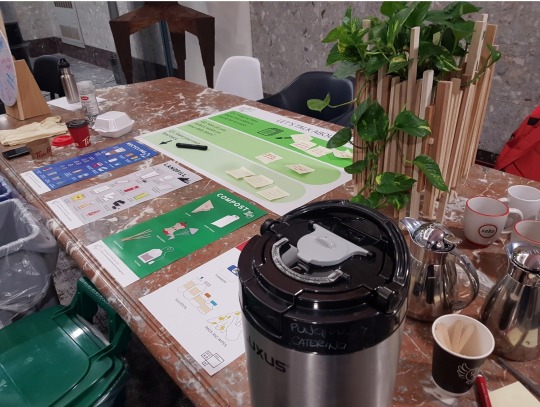
In October, ODESI hosted programming for the national Waste Reduction Week, where we held various events regarding waste at OCADU and how to avoid it. An important component of the icons project was to get feedback from students and the university community about the icons and their effectiveness. Myself along with two internship students (Priscilla Lee and Victoria Gonzales), ran activities at 230 Richmond, and 100 McCaul. We collected common waste items from our homes and brought them in and asked participants to pick two items from our pile. The first item would be one they knew how to dispose of, and one that was perhaps difficult -and confusing for them. Through this activity, participants were able to interact with the icons and use them to make their waste choices, as well as sparking conversations about waste at OCAD, complicated recycling rules, consumption, among many other intriguing conversations.
Signage iterations:
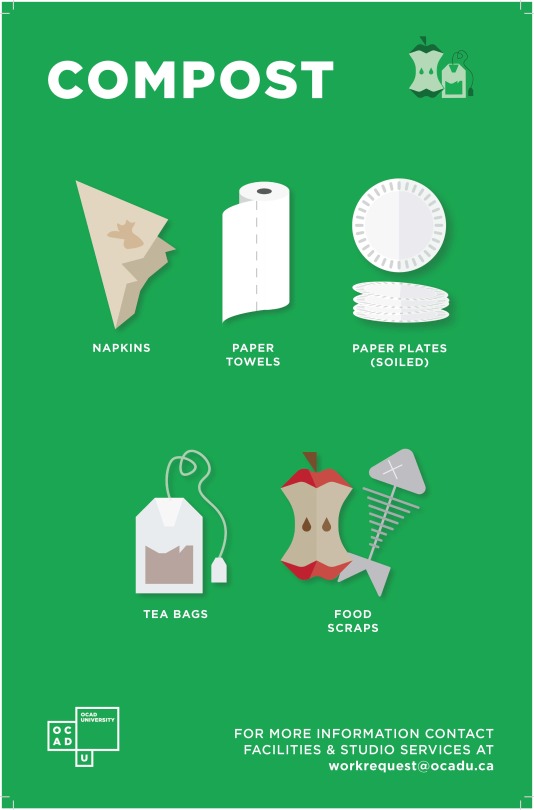
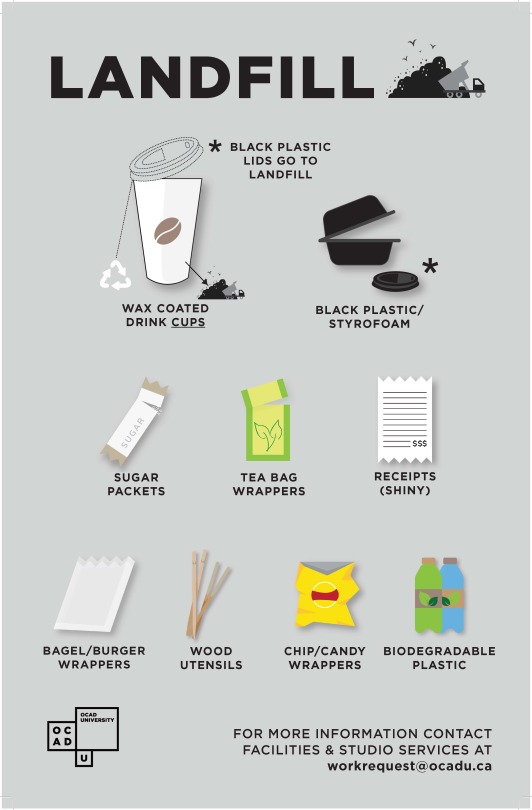
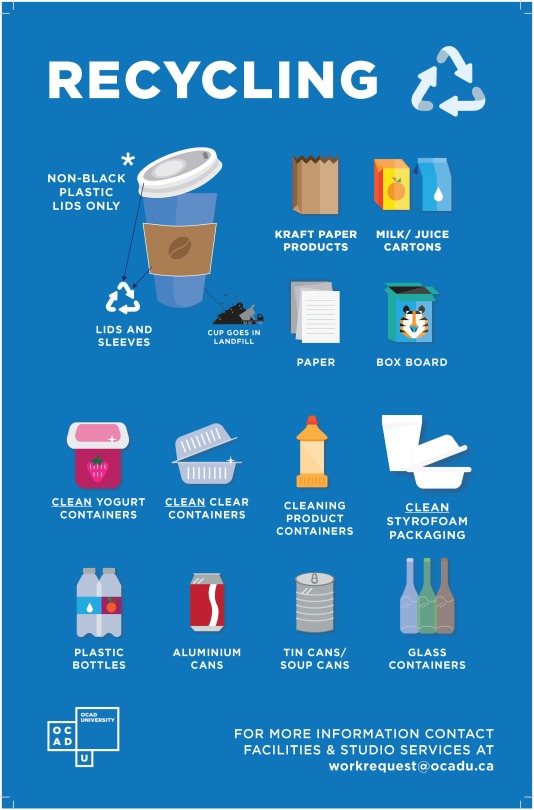
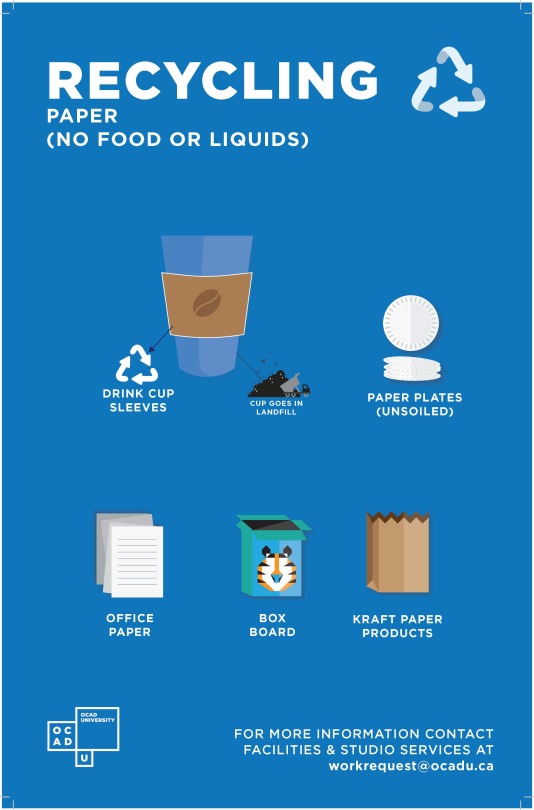
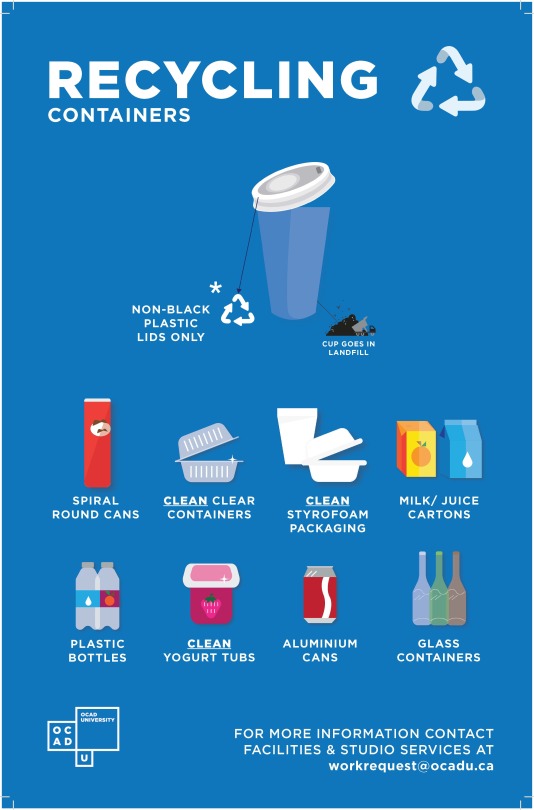
The process of creating these icons was a great opportunity to look into ways in which the waste systems interact with one another and with our capitalist culture of consumption. My role at ODESI gave me an opportunity to work closely with Victoria Ho, the Sustainability Coordinator, who became a mentor and who I worked closely with to complete this project. Her expertise and experience allowed be to broaden my range of knowledge on this topic, and encourages me to question and constantly think about the systems, institutions and industries involved in waste. This project allowed me to make a tangible contribution to this ongoing conversation, and hopefully the icons and waste solutions will evolve and improve as time passes. The posters were put up during GradEx, and seeing them out in the world for the first time was a very very cool experience! I hope that with time, the community begins to familiarize themselves with the icons, and that they serve the purpose long term that we have worked so hard for. I encourage students, faculty and any member of the OCADU community to think twice about consumption, and of where and why we are throwing things away.
Rationale for creating separate recycling streams
The most updated waste management icons follow the City of Toronto’s recycling and landfill requirements. I used the Green for Life lists as a reference, and filtered the items through waste wizard. The intention of having three different recycling signs is to separate possible liquid and food remains in containers (i.e.: Styrofoam containers and plastic water bottles) with paper recycling. If these recycling items are placed in the same bin without proper cleaning and drying, the paper recycling will become un-recyclable and that bag of recycling will become contaminated – leading it to the landfill. We want to ensure that items reach their intended waste management stream, and contamination tends to be the main reason for this not happening.
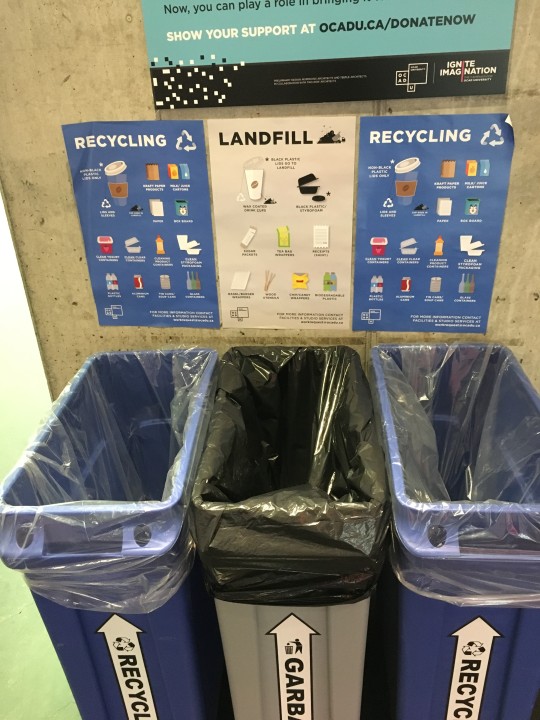
Artist Statement
These waste management icons are tools to aid in the proper categorization of the three streams of waste at OCAD University: Landfill, Recycling and Compost. Contamination is very common in these waste streams, and a design solution to combat this issue that decreases the ability for items to be recyclable, leading them to landfills. I chose to create icons of the items for a more streamlined visual language, and for the ability to control and change colours, shapes, and quantities easily. The idea for this project is that this is the starting point of a system that will change with time and new developments, laws, and methods in waste management.
0 notes
Text
Single Use Plastic Project
What are single use plastics?
Single-use plastics, or disposable plastics, are used only once before they are thrown away or recycled. These items are things like plastic bags, straws, coffee stirrers, soda and water bottles and most food packaging.
Plastic bottles are the most commonly collected plastic packaging type. This is because they are easy to sort and there are well developed markets for the recyclate. The bulk of bottles are made from PET or HDPE, which account for about 90%.
Note: The UK has a much higher use of HDPE bottles than most countries due to its use for containing milk.
Plastic bottles are normally made from one of only four polymer types and are very easily identified, both by members of the public and those sorting the collected bottles. The four polymer types used are:
PET (e.g. fizzy drink bottles and squash bottles)
HDPE (e.g. milk bottles and detergent bottles)
PP (e.g. ketchup bottles)
PVC (e.g. large squash bottles). Although the use of PVC in such applications is in decline
How the UK deal with plastic
Plastics are processed in the UK and abroad. Plastics are separated from your other recyclables at a facility in London and sorted into the different plastic types, including plastic bottles and mixed plastics, such as pots and trays. Plastic bottles are predominantly sent to facilities in the UK for remanufacturing - they are washed and chipped to create plastic pellets which can be remade into plastic bottles. The other mixed plastics are sent to outlets in the UK and overseas for manufacturing into new products.
“None of the recycling we collect is incinerated or sent to landfill unless it is too contaminated to be processed.”
Once the material is sorted, it is sent to reprocessing companies to be turned into new materials and products. Some of these recycling markets are in the UK while others are based outside of the UK. The recycling gets sent to where there is a reliable and financially sound market for the materials.
At present, much of the manufacturing industry that the UK relies on is in the Far East and therefore, some of the material has to be sent there. The material gets turned into a vast range of products, from kitchen appliances, to toys, clothes and packaging.
https://www.youtube.com/watch?time_continue=4&v=fgfTQfKRVPY
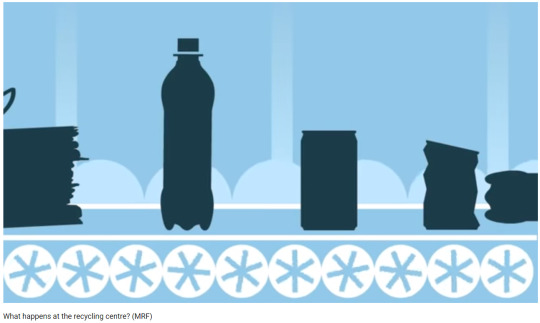
https://www.youtube.com/watch?v=zO3jFKiqmHo
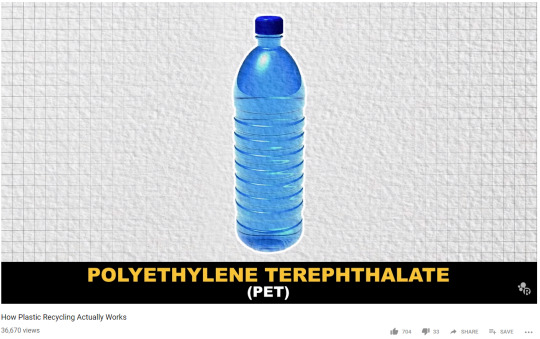
More than 40 companies, including Procter & Gamble, Coca-Cola and Asda, have signed up with the government, trade associations and campaigners to form the UK Plastics Pact.
The Pact says it’s a once-in-a lifetime opportunity to rethink the way we use plastic and its impact on the environment.
Recently, the government said it was considering banning plastic straws and cotton buds and this came hot on the heels of a proposal to make consumers pay a deposit on drinks bottles and cans.
Bans on plastic products
A major step to expand the reduction of plastics beyond bud, straws and stirrers has been announced in the UK Plastics Pact.
Apart from packaging, two of the biggest plastic problems are straws and ear buds. These are among the most widely used items that turn up on beaches around the UK.
Plastic cotton buds are often flushed down toilets and are small enough to pass through water filter systems and end up being eaten by fish and other marine creatures.
The scale of UK plastic straw use is staggering with a figure of eight-and-a-half billion thrown away each year. The government is consulting on these steps with a possible ban to be introduced next year.

Last December, 193 countries committed to a UN plan to stop plastic waste entering the oceans. However, the commitment is not legally binding and doesn’t have a timetable. And different countries have adopted different schemes.
Around 40 have banned single-use plastic bags, with charges or outright prohibitions in place in China, Rwanda and many others including Bangladesh.
Others including the UK are moving to ban plastic straws and cotton buds. Zero plastic waste shops are opening in many towns and cities while plastic-free aisles in stores was part of the 25-year plan for nature in the UK put forward by Prime Minister Theresa May.
Encouraging the Public
some countries are beginning to create collection points for plastics such as bottles in order to encourage more people to properly recycle their waste rather than just throwing it into a regular bin. By doing this, those who hand in plastics will also be rewarded with a small amount of money per plastic, in order to give motivation. Some countries which already operate a similar deposit system have installed “reverse vending machines” to automate the process of reclaiming a deposit.Many of these machines are able to sort, crush and store used bottles.So-called “reverse-vending” has operated since 1984 in Sweden, where more than 90% of household waste is recycled.
Facts on single use plastic
by 2050 the ocean will contain more plastic (by weight) than fish. Studies also found that tiny particles of plastic are already in our food chain and an average person who consumes seafood ingests 11,000 tiny pieces of plastic per year.
full 32% of the 78 million tons of plastic packaging produced annually is left to flow into our oceans; the equivalent of pouring one garbage truck of plastic into the ocean every minute.
https://www.youtube.com/watch?v=RS7IzU2VJIQ
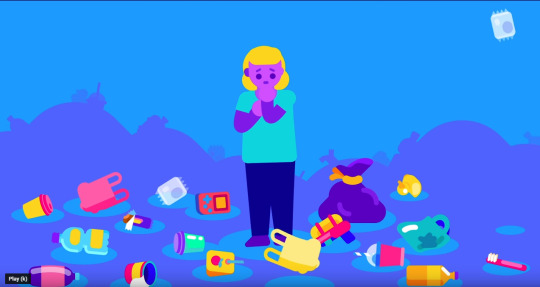
Effects plastics have on the environment and animals
Much is made of plastic’s impact on our marine environments. And rightly so given the massive destruction that plastics can wreak on our oceans. With 80 percent of marine garbage being land-based, 90 percent of that is estimated to be plastic. Unlike other materials, plastic never truly decomposes, it simply breaks into smaller bits that will remain in the oceans forever as a sort of microscopic plastic soup.
Chronic Hunger “The really sad thing about this is that they’re eating plastic thinking it’s food,” says Matthew Savoca, a marine biologist with the National Oceanic and Atmospheric Administration. “Imagine you ate lunch and then just felt weak and lethargic and hungry all day. That would be very confusing.”

Plastic stands to cause intestinal blockages in an animal that consumes it. Death is the ultimate tragedy for animals that consume plastic and this is a sad fate that both wild and domestic animals alike can face.
As plastic bags can take up to 1,000 years to break down, once an animal dies and decays after ingesting plastic, the plastic is then freed back into the marine environment to carry on killing other wildlife.
An animal with its head stuck in a plastic food container may suffer from overheating, suffocation, dehydration, starvation, and eventual death from these elements. It is also not equipped to defend itself from a threat.

In August 2000, an eight metre Bryde’s whale died soon after becoming stranded on a Cairns beach. An autopsy found that the whale’s stomach was tightly packed with 6 m2 of plastic, including many plastic check-out bags. Such obstructions in animals can cause severe pain, distress and death.
Bryde’s whales, like many other types of whales, feed by swallowing large amounts of water. If the Bryde’s whale had died at sea, it would have decayed, releasing the plastic to kill other marine life for hundreds of years to come.
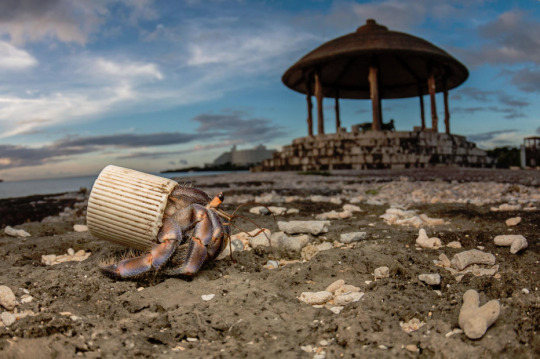
In 1998, a pelican was found dead in Kiama after eating 17 plastic bags.
The pelican presumably thought the plastic bags were food. The pelican was preserved and named Pete. Since then he has been standing in front of a sign at Fitzroy Falls that informs visitors of how he died and the problems of plastic bags and ocean pollution.
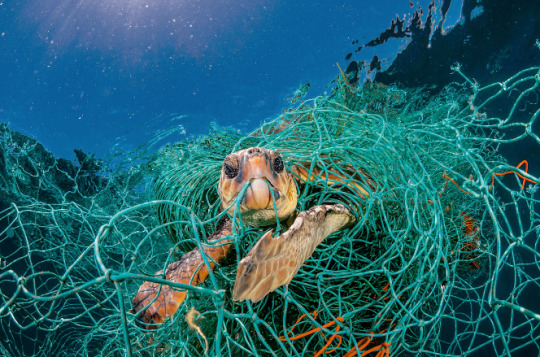
How to reduce single use plastics
Reduce, Reuse and Recycle
Even when single-use plastics are sent to landfills (there are 3,091 active landfills in the U.S. alone), they aren’t harmless. Landfill liners can leak harmful pollutants into the watershed and plastics on the tops of landfills can be carried away by the wind.The best way to curb single-use plastic pollution is to reduce your personal plastic consumption!
In order to reduce paper cup waste, are the schemes of a few coffee chains, like Pret A Manger, who introduced a discount of 25 to 50 pence if you bring our own reusable mug. They hope this incentive may help change consumer habits. Besides saving in your morning coffee expenditure, you will also be helping to reduce wastage sent to landfills.

Americans purchase about 50 billion water bottles per year, averaging about 13 bottles per month for every person in the U.S.! That means by using a reusable water bottle, you could save an average of 156 plastic bottles annually.
You can easily reduce your plastic bottle consumption by:
Installing a filter system in your house or purchasing a filtering jug
Getting a reusable water bottle
Drinking tap water when possible

Half a million straws are used in the world every day. Refusing straws is becoming a trending practice!
Next time, rethink and refuse plastic bags! There are many alternatives to plastic shopping bags, like canvas bags, reusable bags, backpack, or even cardboard boxes. Try to always carry a reusable bag with you and try to avoid plastic bags next time you go shopping.
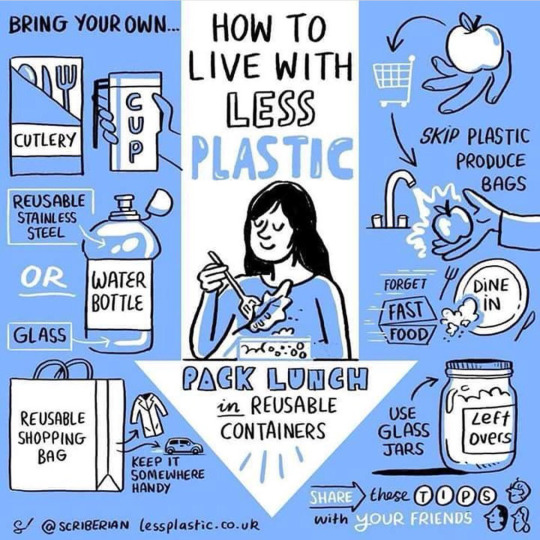
Videos that provide ideas on how to reuse plastic
https://www.youtube.com/watch?v=UuysL6OXeLo

https://www.youtube.com/watch?v=NwYXf_SJXSo
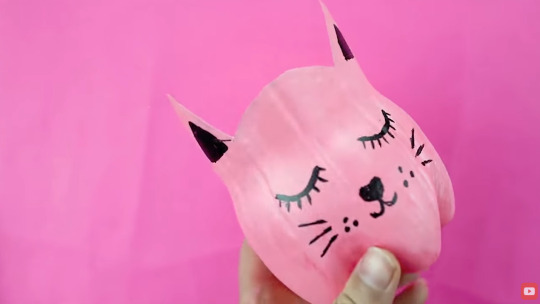
https://www.youtube.com/watch?v=edXimuzIVhk

https://www.youtube.com/watch?v=1MvbNwmqDvY

Biblography
https://www.nationalgeographic.com/environment/plasticpledge/
http://www.onegreenplanet.org/environment/ways-plastic-pollution-impacts-animals-on-land/
https://www.earthday.org/2018/03/29/fact-sheet-single-use-plastics/
https://www.clearpublicspace.org/blog/reduce-reuse-recycle/the-impact-of-single-use-plastic-in-our-lives
https://www.nationalgeographic.com/magazine/2018/06/plastic-planet-animals-wildlife-impact-waste-pollution/
http://www.greeneducationfoundation.org/nationalgreenweeksub/waste-reduction-tips/tips-to-use-less-plastic.html
http://www.plasticfreechallenge.org/what-is-single-use-plastic/
https://www.bbc.co.uk/news/uk-42703561
https://www.recycle-more.co.uk/how-is-it-recycled-/plastic-recycling
http://www.wiseuptowaste.org.uk/recycle/what-happens-to-my-recycling/
http://www.prijatelji-zivotinja.hr/index.en.php?id=934
References for infographic deigns
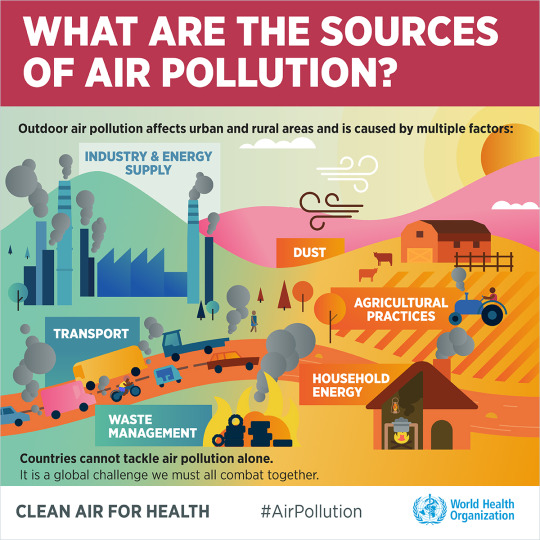


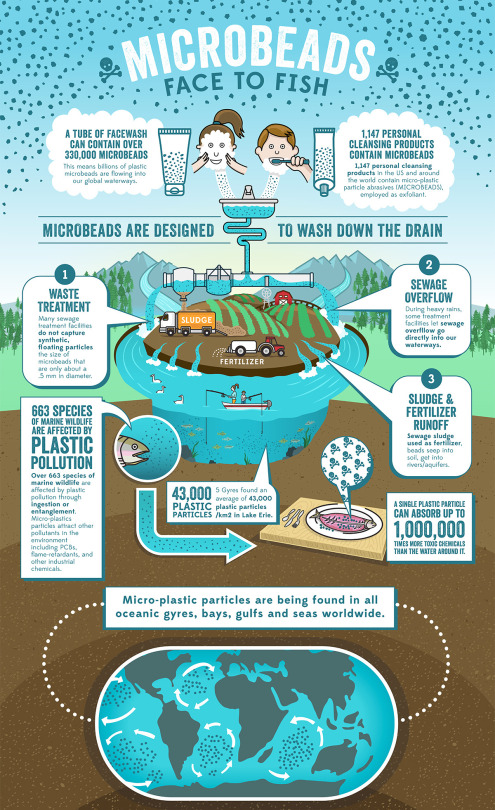
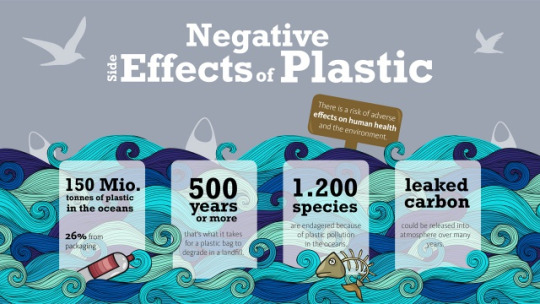

(Found from google images)
Vector design/style ideas

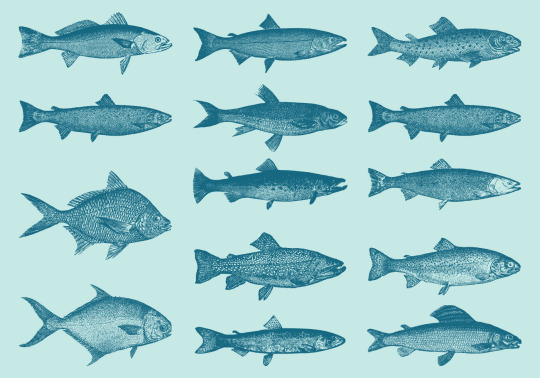
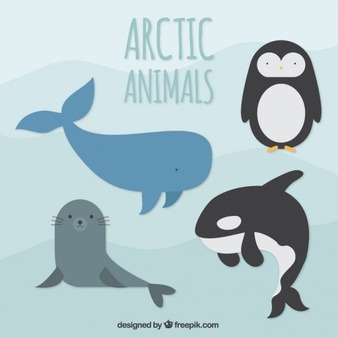
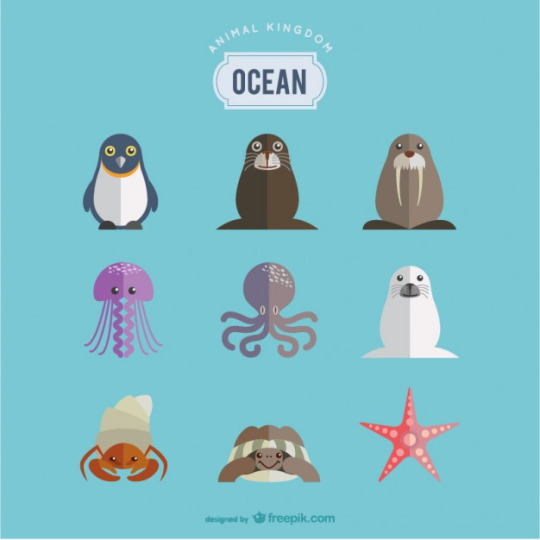
Colour Palettes






Idea Development
The angle I am going to take on this project will be through the impact on all animals, aquatic and land-based, however my focus will be aquatic. Due to the period making it a bit difficult to fit both in along with other information, I will see how I progress to determine how much of each I will put time into.

My animation will begin on some basic, short facts on plastic, where it comes from, how long it takes to degrade etc., and then move over onto the impact it has on animals due to this. If I can find free use photos of animals in situations caused by plastic, I will use some, but if not I will use illustrator to make vectors of them (this would also be good as I could animate them).

The video will then move over to things we can do to help animals, and ourselves, including a few ideas of recycling, and a few countries that are making huge movements in reducing plastic consumption.

My animation will be designed with a cute theme, with most of my art coming from illustrator vectors, and I’m thinking of creating a sort of mascot turtle that will go through the video with the viewer to explain everything. The video will include mostly soft, complementing colours, and then I would save contrasting colours for important messages in the text, or for certain bits of art to draw attention to that point.
I want to use quite soft music to match the video, perhaps a piano piece or just relaxing music in general, but I will be able to pinpoint the best sounds once I have made a firmer design of my animation.

Turtle Mascot Sketch Ideas

Fave 2
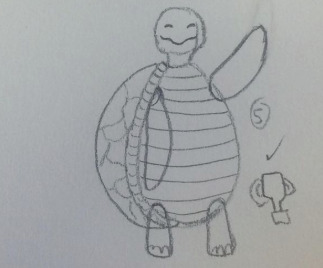
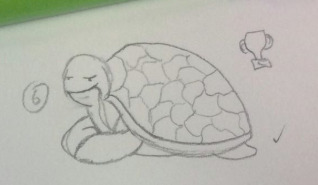

Font
I have chosen this font without too much regard to others, as I have used this one before for a similar cute style, and I think it will fit perfectly with my ideas for this animation. Its hand-drawn and “cutesey” but it is also really easy to read in all point sizes, so it will be really easily adapted into my work.




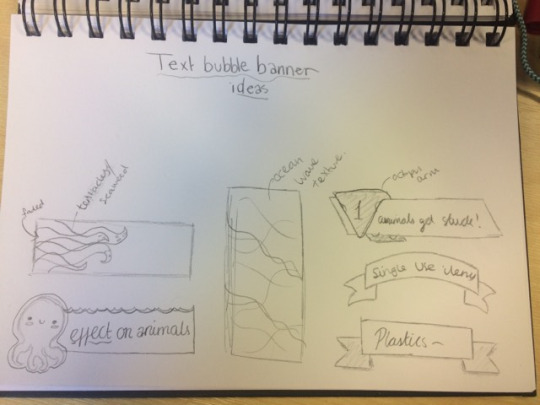
Background Scene Sketches


0 notes
Text
Video Killed the Beautiful View
"The sound brought our group to a stop; we turned around to see the ice mass collapse with a roar. A section of the glacier crumbled in the middle, and chunks of ice as big as rooms spilled out on the crater floor."
A description given by adventurer Vince Keipper as he summitted the top of Tanzania's Mount Kilimanjaro and looked back. The fact is, the beautiful glaciers which give Mount Kilimanjaro its distinct appearance are disappearing at an alarming rate. Legendary author, Ernest Hemingway once used the following description to illustrate those 12,000 year old legendary peaks, "as wide as all the world, great, high, and unbelievably white in the sun", but, few can say that now. Those very glaciers have lost 82 percent of their ice since 1912, and at the current rate of erosion, they will be ancient history by the year 2020. This is only one example of the devastating affect global warming is having on our environment.
So what does all of this have to do with technology? .....A lot!
Rapid technological change, low initial cost and even planned obsolescence have resulted in a high rate of turnover for network hardware appliances, creating a fast growing problem around the globe. IT manufacturers with financial incentives are brilliant at encouraging customers to buy the next iteration of their product, even if the existing one still works. The short lifespan of today's IT equipment such as, de-installed routers and network switches from manufacturers such as Cisco, Juniper, Alcatel-Lucent, Nortel, Foundry and Extreme are contributing to a new form of scenery like, mountains of e-waste. Accumulated e-waste is either dumped in landfill sites or recycled in the secondary market. They are often processed in poorly managed facilities, in developing countries, leading to significant health risks and causing a major negative impact on the environment.
Did you know that chemicals such as lead, mercury, and cadmium emitted from discarded electronics are some of the biggest producers of greenhouse gases worldwide? A typical router or switch may contain more than 2% lead by weight, and up to thirty-eight separate chemical elements. A 24kg PC or server from manufacturers such as HP, Dell, Sun and IBM needs at least 240kg of fossil fuels and 22kg of chemicals to provide its energy. Compare this with cars or refrigerators, which use only between one and two times their weight in fossil fuels. Furthermore, The UN warns that people could be exposed to health risks at both ends of the short lifespan of networking equipment. Chemicals such as brominated, flame retardants and heavy metals including lead and cadmium pose potential risks to factory workers and can also contaminate water supplies near landfill sites where old computers are dumped.
Due to lower environmental standards and working conditions in China, India, Kenya, and elsewhere, electronic waste is being sent to these countries for processing - in most cases illegally. The majority of defunct and junked e-waste ends up being broken down by ill-equipped laborers in hazardous conditions. Uncontrolled burning and disposal are causing environmental and health problems due to the methods of processing the waste. Slowly, these disposal methods emit harmful gases which deplete our atmosphere and have emerged as a major contributor to global warming.
Each year, more than 130 million computers are produced worldwide. In the United States alone, an estimated 14 to 20 million PCs and network appliances are thrown out each year, while developing nations are expected to triple their output of all electronic waste by 2010. By 2005, more than 250 million personal computers will become obsolete. This is evidenced by the average lifespan of PCs, which is falling from 4.5 years in 1992 to an estimated 2 years in 2005. Across the European Union, electrical equipment is the fastest growing category of rubbish, with around 20kg per person produced every year, and, "the UK alone is now generating around 1m tons of the stuff every year," said energy minister Malcolm Wicks.
If you do the math, it is clear, that the current trend of mass production with no regard for corporate social responsibility cannot continue. If we continue at our current rate of consumption, our children can look forwards to inheriting a world with blistering temperatures, severe storms, and 13 of the world's 15 largest cities submerged by seawater. Imagine a complete loss of coral reefs, the disappearance of Pacific islands, the extinction of thousands of species of plants and animals, contamination of fresh water supplies and more than a hundred million refugees. Those of us who have not been living under a rock have, no doubt, already noticed a drastic change in the last 2 years alone.
It is no coincidence that 2005 brought the onslaught of the deadliest hurricane season on record, climaxing on Monday, 29 August 2005, when Hurricane Katrina careened into the Gulf Coast, putting 80% of New Orleans under water, resulting in the nation's most costly natural disaster ever recorded. Katrina claimed more than 1,600 lives, destroyed 200,000 Gulf Coast homes, and displaced about 1 million people. But, that is nothing compared to the devastation and loss of life experienced just one year prior, when on December, 26th the deadliest tsunami in history pummeled the coast of Southern Asia, and shocked the world with a reported death toll at more than 300,000 people. Most recently, and fortunately, less costly than the previous examples cited, are recent reports about the 2006/2007 winter being the warmest and driest on record.
How many more weather related records do we need to break before we wake up? How many more people need to lose their lives through violent weather changes? Global warming is real, and we can not continue looking the other way. It is because of this lack of awareness that environmental impact is seldom a major factor in corporate buying decision. However, the consumption culture as we know it, is about to drastically change.
This information is not intended to scare you, but rather to serve as evidence to the changing world around us. Human beings are a robust species, and historically we have always adjusted to survive. We need to acknowledge the signs around us and react before it's too late. For years now, the United Nations and Greenpeace have been warning of the dangers that computers, IT hardware and other office equipment pose to the environment. This change will begin with awareness, and ultimately result in a radical new green ideology.
The days when businesses could send a product into the marketplace without first considering how it might impact the environment are over. Global recycling and product recovery programs, where businesses take responsibility for what they make and sell are already under way worldwide.
Soon, green legislation will have an impact on every manufacturer in the world. "Not far from now, 'non-green' parts will be assigned end of life status and green legislation will come to impact every single PC manufacturer," said Mike Escherich, the principal research analyst at Gartner (leading information and technology research and advisory firm). "The worldwide market should expect to see longer lead times, part shortages and rising prices for non-compliant parts over the next two years. These costs will probably be passed on to consumers. Analyst firm Gartner estimates that it could add about £30 to the price of a new PC in Europe. A small price to pay for our future generations well being.
After many delays, The Waste Electrical and Electronic Equipment (WEEE) regulations governing the safe disposal of IT equipment were finally passed into law in the European Union, confirming that the new legislation will come into full effect in July of 2007. The law will place a greater administrative burden on suppliers of computer equipment. They will have to register with waste schemes and more closely track their products in order to pay for their disposal. Under the new law, manufacturers will have until March, 15th 2007 to register with approved disposal schemes, and by 1 April all new equipment will have to be marked with WEEE labels displaying a crossed out wheelie bin and date code. The directive will then come into full effect on 1 July, with producers taking responsibility for treating and recycling household and business WEEE.
The first of its kind, but certainty not the last, this pioneering green computer law, is setting the stage for the future. Similar laws and regulations are being considered now in the United States. Congress is debating a number of electronic waste bills including the National Computer Recycling Act introduced by Congressman Mike Thompson (D-CA). This bill has continually stalled, however. In the meantime, several states have passed their own laws regarding electronic waste management. California was the first state to enact such legislation, followed by Maryland, Maine, and Washington. It is only a matter of time until general ethics evolve to include electronic waste disposal. For our children, the idea of throwing an old monitor in the dumpster will be as unsettling as it is form some of us to throw trash on the floor.
Several new businesses have emerged to meet this new demand, and help companies comply with the new legislation outlines for approved disposal schemes. One such company was recently established by the CEO of Digital Warehouse and UsedCisco.com, Joe Asady. The new business is called, Network Recycler.com. "Our model is to help protect the environment by providing a system and environmentally friendly way of disposing of end of life network equipment" said Mr. Asady. He then enthusiastically elaborated on his concept, "NetworkRecycler.com will be your single source recycling service provider. We can help you stay in compliance with government regulations by properly disposing of your obsolete and excess network and communication equipment". NetworkRecycler.com has opened offices in New York, Amsterdam and Bangalore, India to help meet the growing worldwide demand for recycling network hardware. Everyone at the newly established business is very excited about the recent ideological changes sweeping Europe, and soon to reach the United States. Mr. Asady described his team as enthusiastic and optimistic, "people here are excited about making a difference, and it is really nice to be a part of something that is helping protect the world we live in". Several other similar companies are forming worldwide, and soon, an entirely new industry will emerge from the concept of E-waste recycling.
Mr. Asady's vision does not end there. As the CEO of both Digital Warehouse and UsedCisco.com he has been protecting the environment since 1998. Both businesses fore mentioned are major players in the global secondary market for used network hardware. Facilitated by the new awareness for computer recycling, an already, $3 billion dollar used network hardware industry is poised to grow considerably in the upcoming years. "Traditionally, people would shy away from used equipment because of the inherent risk that it presented", Claimed Mr. Asady. "However, with current competition in the secondary market we have raised our quality standards. We now provide guarantee's that outlast even the original warranty given when the unit was new".
Used network equipment is often renovated by various resellers such as Digital Warehouse. Afterwards, they are sold in the secondary market at up to 90% off of list price. Products are available even in the most sophisticated and obscure models, and when they come with a warranty that supersedes even that of the original manufacturer customers are often jubilated with the value. Not to mention, when they buy used equipment they are also helping to eliminate e-waste and protect our environment.
One in every dozen computers used worldwide is a "secondary computer," and about 152.5 million used systems were shipped in 2004, according to a study released Wednesday by market research firm Gartner. Gartner also said that both the home and professional markets for secondary PCs will continue to see growth in the next several years, fueled by better computer performance, longer system life, and recent recycling legislation that gives companies a greater incentive to sell their used machines. I am sure Mr. Asady and his team will have their hands full in the coming years with the recent explosion of wealth and opportunity in places like India and China. Through recent advances in technology, coupled with complex new economic foreign policies abroad, developing countries are much more likely to accept used hardware as a viable technology option because of the savings they afford.
To put this all into perspective, I want to cite the following example: When Henry Ford invented the automobile, the world was transformed by its speed and convenience, but few people considered what millions of automobiles might mean for the world's energy supply and climate a century down the road. Hopefully, we can learn from the lessons of our ancestors during the industrial revolution, and preemptively react for the current computer revolution sweeping our planet. The days when businesses could send a product into the marketplace without first considering how it might impact the environment are over. Global recycling and product recovery programs, where businesses take responsibility for what they make and sell, require little effort on the part of consumers, and they pay off!
Whether you are an IT manager, global CEO or a mere home PC user, the implications are the same. E-waste is a problem, e-waste is real! Although we are taking some steps in the right direction, a lot more needs to be considered. So please, do your share to get involved with e-waste awareness, help efforts to reduce energy demand and greenhouse gas emissions and start to consider the secondary market as a viable alternative to purchasing new equipment. Most importantly, help spread the word!!
http://www.usedcisco.com
Article Source: http://EzineArticles.com/expert/Joshua_Levitt/61175
http://bit.ly/2VZVVhl
0 notes
Text
Your New Year’s Resolution: Better Recycling Practices
Beauty is in the eye of the beholder. That’s an old classic saying, but is it true?
How about garbage? Is garbage beautiful?
Maybe, if you know how to make it “un-garbage”.
Take this year as an opportunity to do the planet a great favor by avoiding the landfill in favor of recycling.
Science Weighs In
In a closed system, like the Earth, where very, very little mass ever exits orbit to enter outer space, the total amount of energy can change from one form to another, but cannot ever be destroyed.
The things we make out of any material, whether simple or complex, natural or synthetic, organic or inorganic, are going to stay right here in our neighborhood garbage dump or even in the ocean when we are done using them.
So, challenge yourself and assess your recycling practices.
Glance around your room for about 30 to 60 seconds. Try to imagine the length of time the items you see will remain in a useful condition. This length of time is called ‘the useful life of an asset’ by the United States Internal Revenue Service.
If you see a lot of things that can be used for a long time, then that’s great! However, if you see more things with lower useful life, then that’s going to be a problem.
For example, gadgets and other products of technology are great when they are new. They are useful and enjoyable to use. Once newer and more innovative devices are introduced, your gadgets become less and less useful.
Removing the old technology, sometimes called e-waste, is a huge problem in both personal and business settings.
Getting Practical
Practice makes perfect. Now, that’s not quite correct as only perfect practice makes perfect. Imperfect practice makes imperfection and that is the recycling system of today. We are, as a whole, still uneducated on the correct recycling procedures.
For example, what is the negative result that comes from single-stream (unsorted) recycling?
The answer is often unsorted trash put in the recycle bin that doesn’t end up getting properly recycled at all.
How and Why to Recycle the Weird Stuff
If you’re not sure where to start with recycling, here are a few tips you can use:
Aerosol Cans– Valuable for their steel, they may go in a bin or taken to a recycling center. Car Batteries– Valuable for their lead, you can turn them in for money at a scrap yard. Pet Fur– Valuable for its ability to absorb oil, you can donate them to proper institutions. Pantyhose– Valuable for its nylon, they can be repurposed as well as recycled because they are stretchy and strong. Vegetable Peels– Valuable for making dirt, you can turn them into fertilizers.
See Also: How To Recycle Copper Scrap
Disasters Spell Disaster for Recycling
When destructive natural causes wreak havoc in a certain area, caring for survivors, preventing diseases, and restoring health and safety services as soon as possible are top priorities. The most vulnerable segments of society suffer deeply in times of natural disaster and unfortunately, there’s a disparity in the fair distribution of resources and aid. Removing damaged and dangerous remnants, even when help arrives swiftly, can still take all too long to accomplish.
Because there are so many things we have to deal with during a natural disaster, recycling isn’t given much priority. There’s not enough room to add a recycling mandate on the clean-up crews’ list of responsibilities and this can spell bad news. There’s the risk of exposure to black mold, sewage contamination or storm residues.
When times are okay and we’re not dealing with any disaster, we hardly think about access to clean water and air. We enjoy uninterrupted services and access to the goods we want to buy and use. The only time we think about and appreciate those things is during a natural disaster.
This year, don’t wait for a disaster to strike. Start doing better recycling practices to avoid regrets later on.
See Also: 10 Ways to Enjoy a Zero-Waste Lifestyle
The Future is Now
We said progress and progress we shall have.
Waste can become a resource and a path for revenue. Since the concept of recycling has improved over the years, it’s now making more of a difference than ever before.
That’s the good news.
Ecologists, environmentalists, and ordinary people who participate in increasing society’s awareness on recycling continually work hard to improve the quality of the recycling process. They put an effort to let in more types of products, process more substances, and form new goods out of old materials.
Students in college programs majoring in ecology and environmental studies in the U.S. and abroad are working hard before and after graduation to contribute to our sustainable future.
Garbage is beautiful when it is the topic of a positive problem-solving conversation. The infographic below has a number of salient talking points to get us speaking (and listening!) together about caring for our big blue and green planet.
Let’s recycle and be smart! Source: It’s Not Trash
The post Your New Year’s Resolution: Better Recycling Practices appeared first on Dumb Little Man.
from Dumb Little Man https://www.dumblittleman.com/recycling-practices/
0 notes